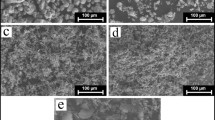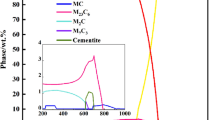Abstract
To obtain a copper alloy with a higher softening temperature, a Cu-Ni-Ti alloy was obtained by the traditional smelting method. And, on this basis, we discuss the effects of atom percentages of different Ni-Ti alloys and the mass percent of Ni + Ti on the properties of single-stage aging of Cu-Ni-Ti alloys at 600°C. The results indicate that the alloy with a Ni/Ti atomic ratio of 2 and a total Ni + Ti content of 3 wt.% exhibits the best performance match. After aging at 600°C for 8 h, the Cu-Ni-Ti alloy’s softening temperature exceeded 720°C. This property surpasses that of most age-hardened copper alloys. The corresponding hardness and conductivity were 171 HV and 58% IACS, respectively, which is slightly lower than the commonly used time-reinforced copper alloy. After calculation, the Cu-Ni-Ti alloy with a Ni:Ti atomic ratio of 2 and a total Ni + Ti content of 3 wt.% is referred to as the Cu-2.13Ni-0.87Ti alloy. Transmission electron microscopy observations indicated that the precipitated phase in the aged Cu-2.13Ni-0.87Ti alloy consists of dispersed nanoparticles of Ni3Ti, which have a semi-coherent interface relationship with the matrix. Upon holding the peak-aged Cu-2.13Ni-0.87Ti alloy at different temperatures for 1 h, it was noted that the precipitates exhibited significant coarsening. Furthermore, when the holding temperature surpassed 700°C, the rate of coarsening increased significantly, accompanied by a rapid decline in hardness.









Similar content being viewed by others
References
A.M. Sadoun, M.M. Mohammed, A. Fathy, and O.A. El-Kady, J. Market. Res. 9(3), 5024 (2020).
C. Li, W. Zeng, Y. Xie, J. Wang, J. Liang, R.E. Logé, and D. Zhang, Mater. Sci. Eng. A 778 (2020).
A.G. Raab, D.A. Aksenov, R.N. Asfandiyarov, I.S. Kodirov, and G.I. Raab, IOP Conf. Ser. Mater. Sci. Eng. 447, 012088 (2018).
S. Asgari, R. Sharghi-Moshtaghin, M. Sadegh Ahmadi, and P. Pirouz, Philos. Mag. 93(10–12), 1351 (2013).
H.S. Ren, X. Wu, B. Chen, H.P. Xiong, and Y.Y. Cheng, Weld. World 61(2), 375 (2017).
Y. Cao, S.Z. Han, E.-A. Choi, J.H. Ahn, X. Mi, S. Lee, H. Shin, S. Kim, and J. Lee, J. Alloys Compd. 843, 156006 (2020).
J.S. Chen, B. Yang, J.F. Wang, X.P. Xiao, H.M. Chen, and H. Wang, Mater. Res. Express 5(2), 51 (2018).
Q.Y. Dong, L.N. Shen, F. Cao, Y.L. Jia, K.J. Liao, and M.P. Wang, J. Mater. Eng. Perform. 24(4), 1531 (2015).
Y.J. Zhou, K.X. Song, J.D. Xing, and Y.M. Zhang, J. Alloys Compd. 658, 920 (2016).
W.N. Liao, X.F. Liu, Y.H. Yang, and M. Du, Mater. Sci. Eng. A 767(1), 38428 (2019).
Q.M. Dong, Heat Treat. Met. 30, 182 (2005).
L.J. Peng, B.Q. Xiong, G.L. Xie, Q.S. Wang, and S.B. Hong, Rare Met. 32(4), 332 (2013).
I.Z. Awan, and A.Q. Khan, J. Chem. Soc. Pak. 41(1), 1 (2019).
J.H. Su, S.G. Jia, F.Z. Ren, P. Liu, and B.H. Tian, Adv. Mater. Res. 79–8(2), 1507 (2009).
Y.L. Jia, Y. Pang, J. Yi, Q. Lei, Z. Li, and Z. Xiao, J. Alloys Compd. 942, 169033 (2023).
W.J. Zhu, L.I. Duarte, and C. Leinenbach, Calphad 47, 9 (2014).
H. Zhang, Y. He, F. Yang, H. Liu, and Z. Jin, Thermochim. Acta 574, 121 (2013).
Acknowledgements
This work was supported by National Copper Smelting and Processing Engineering Technology Research Center (No. 20231ZDD0205) and the Natural Science Foundation of Jiangxi Province (No. 20225BCJ22013).
Author information
Authors and Affiliations
Contributions
Yu Sun: Conceptualization, Methodology, Writing - original draft. Dongdong Lv and Jinping Liu: Data curation, investigation, conceptualization. ChengjunGuo and Shengda Guo: Investigation, Formal analysis. JianBo Zhang: Supervision, Writing—review and editing.
Corresponding author
Ethics declarations
Conflict of interest
The authors declare that they have no known competing financial interests or personal relationships that could have appeared to influence the work reported in this paper.
Additional information
Publisher's Note
Springer Nature remains neutral with regard to jurisdictional claims in published maps and institutional affiliations.
Rights and permissions
Springer Nature or its licensor (e.g. a society or other partner) holds exclusive rights to this article under a publishing agreement with the author(s) or other rightsholder(s); author self-archiving of the accepted manuscript version of this article is solely governed by the terms of such publishing agreement and applicable law.
About this article
Cite this article
Sun, Y., Lv, D., Liu, J. et al. A Cu-Ni-Ti Alloy with Excellent Softening Resistance Combined with Considerable Hardness and Electrical Conductivity Obtained by the Traditional Aging Process. JOM (2024). https://doi.org/10.1007/s11837-024-06665-5
Received:
Accepted:
Published:
DOI: https://doi.org/10.1007/s11837-024-06665-5




